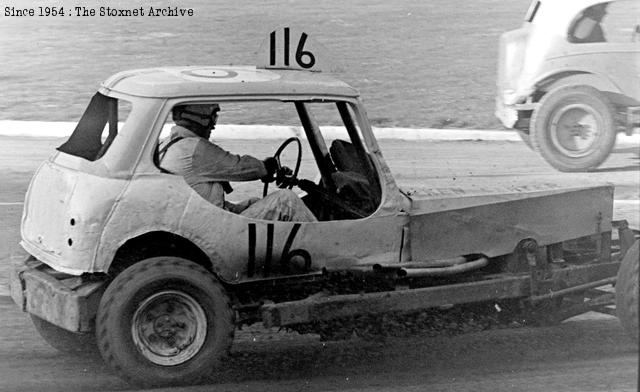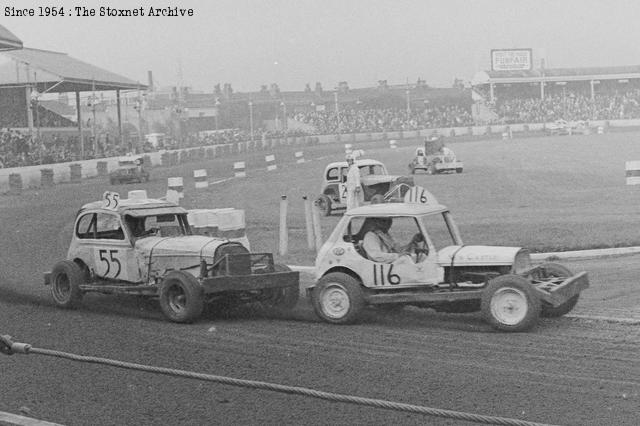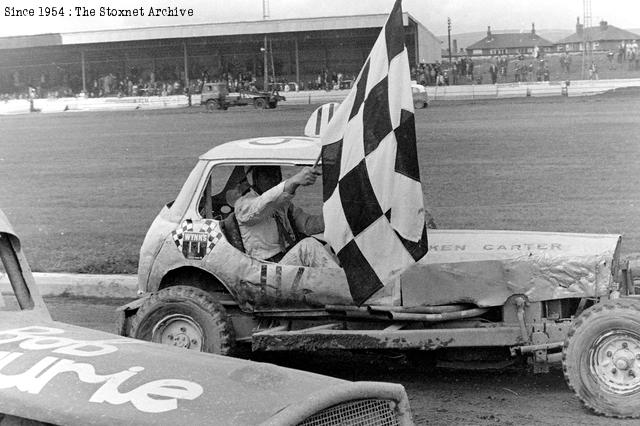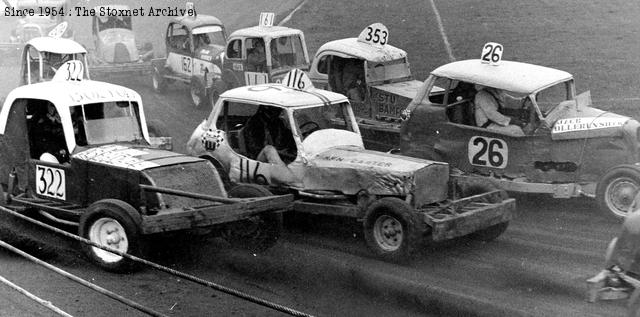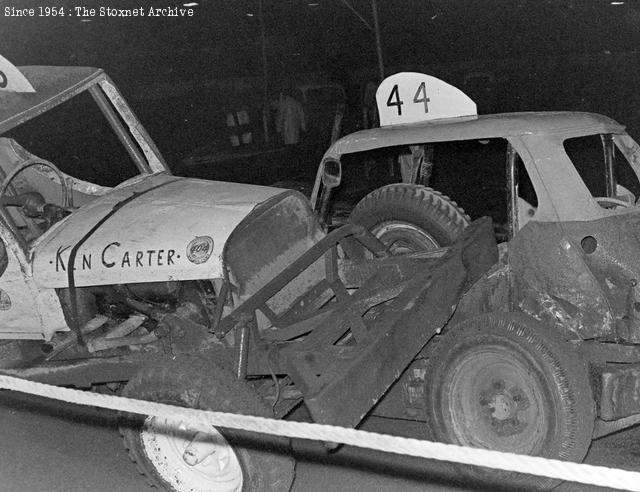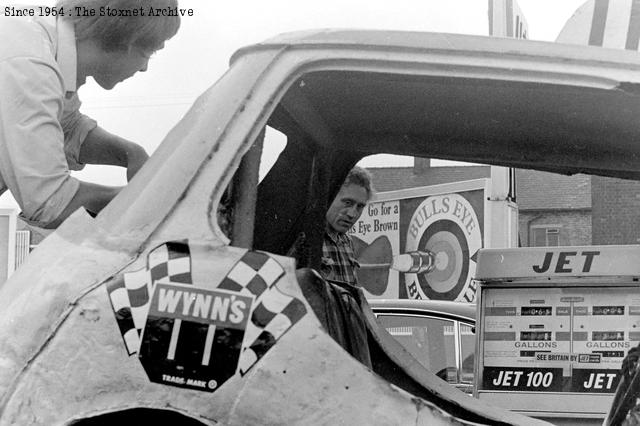Chadderton, Lancashire
115 (1963-1965)
116 (1966-1972)
We are back in the Sixties again kids, a time when Mars bars were huge and Jacobs Wagon Wheel biscuits were sold with a stick to assist the purchaser in rolling them home. A pair of complete LD axles cost a fiver (cries of 'Rip off!'). A complete Jaguar saloon was on offer for £15.00. The local chippy would take your crisp quid, deliver six of Murphys and an Ocean Rambler and the change would leave enough for another fifteen portions.
The bit about the Wagon Wheel may be a slight exaggeration (you had to take your own stick) but as for the rest, all true. There really was a pound that you could fold! More relevant to our Grande Arte (movie reference to the Peter Coyote flick), a sports minded young chap could rock up at Belle Vue Stadium with anything on wheels, perform in front of thousands and be paid for his trouble. In the case of your humble scribe, the start money exceeded a week's wages. There was the massive investment of £45 in the car to find, and without generous help from good people with the logisitcs of transport and storage the whole circus act would have collapsed. Fifty odd years later, thank you guys!
One helpful guy was Ken Carter, from Chadderton. He came to the sport a lot later than some; in 1963 he was approaching his middle thirties when he appeared at BV with his self crafted car. Ken was a diesel engineer by profession and the car he produced reflected this. The new British Standard stock used most of an Austin or Morris LD van at this time but some axles were better than others for the job and the vintage of the chassis selected had some bearing on the end result. There is an image of this car below, wheeled by its fifth owner Johnny Jones. The condition is not great but the durability is still evident.
Motive power for the 115 was unusual, but there was a provenance for the choice. The Bedford S Type petrol engine was based on a straight six design which went back many years. The just shy of 5 litre capacity was a plus point, but the modest rpm at which its 120 hp was produced limited top speed.
The engine had been used previously by a young Yorkshireman called Willie Harrison and actually won a final at Sheffield back in the fifties. This unlikely choice for 1963 was fettled by Ken to get the maximum performance out of the thing. The single carburettor was replaced by a pair of enormous SUs which involved the manufacture of the hardware needed to mount them. Exactly how many extra horses the mods liberated is not known, but the car qualified on a regular basis in the two seasons it was raced by its creator and even logged a Grand Final fifth when a traditional Manchester downpour levelled the field. Ken pointed out the lack of top speed to a subsequent owner, but you could still scare yourself in it he added.
The sale of the car to Denton's Pete Richards (387) went towards a new car for 1965. A Cadillac parked on a pub car park not too far from the stadium proved to be buyable, but the car came with a cracked engine block due to freezing up over the winter. The right kind of filler rod and Carter expertise fixed that The new car was LD based once more but the rear end was chopped and a pronounced kick up resulted. The rear axle rode on quarter elliptic springs controlled by radius rods, not unlike the Aubrey Leighton car, noteable by its absence 1965, and destined to elevate the status of Willie Harrison in later seasons.
The front axle of the new build was all LD. What was not standard practice was the distance between the axles, a modest 90 inches. This was the wheelbase employed by Albert Griffin, and proving a real handful for the 178's chauffeur. The new car sat on 13 inch wheels, used 7.50 section tyres and was very compact. For the next several years the BV commentator would point out that the 115 was, quote, the smallest car here tonight, unquote, and he was generally correct, although one night in 1968 a brave soul by the name of Ed Hall took the laurels, deathtrap is a word which come to mind when viewing his creation. The number was 17 and an image can be seen on the BriSCAF1stoxsite.
The engine in the 115 was a modest 331 incher, but on the line performance wise. The Carter AFB carburettor was a mystery for a while, but eventually mastered and there was a set of quite good fabricated exhaust headers reminiscent of a 50s hot rod. The build was not rushed and did not surface until late in 1965. It proved a massive leap forward from the Bedford. Around this time Ken set up in his own right and opened premises in Rylance Street in Ardwick, not far from the BV stadium.
The Cadillac was used throughout 1966. The number on the side was now 116, and bowed out with a place in a BV Final. For 1967, a later design in the form of a Ford FE (the E stands for Edsel), only a 352 but the the heads were reworked and tuned length headers added. There were also modifications to the oil pan to ensure efficient lubrication. A major change was the wheelbase going out to 98 inches and a transverse spring replacing the semi elliptics at the front. The objective was better weight distribution and improved traction. Ken opened his '67 campaign with a place in Heat, Final and Helter Skelter. That was followed with a Heat win at the following meeting, the first of two that year.
Ken raced less in subsequent seasons, and very nearly pulled off a Final win in '69, finishing just behind Frank Bourne at Belle Vue. 1970 was a little busier with Rochdale now available, there was a another Heat win scored here. The pace of racing was leaving the little Ford behind, and Ken elected not make the commitment to produce a new car, although a couple of manufacturers lengths of 2½ x 2½ inch SHS were ordered. The word from Alan Heap was that these went into Rob Bradsell's first self-build.
Ken Carter bowed out with a single meeting at White City in 1972, the still game little Ford went to George Stringer and produced at least one other win, at Nelson.
John Nolan
| 1. | Monday 27th March 1967 | Belle Vue | Heat 1 |
| 2. | Saturday 8th July 1967 | Belle Vue | Heat 2 |
| 3. | Sunday 28th June 1970 | Rochdale | Heat 2 |
| 1. | 27 Mar 1967 | Belle Vue | Ht |
| 2. | 8 Jul 1967 | Belle Vue | Ht |
| 3. | 28 Jun 1970 | Rochdale | Ht |
